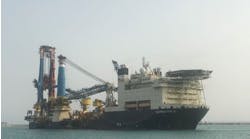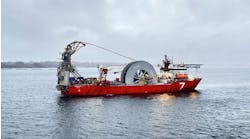Offshore staff
ATYRAU, Kazakhstan – North Caspian Operating Co. (NCOC) has provided an update on its efforts to resolve problems at the Kashagan field offshore Kazakhstan.
Production started on Sept. 11, 2013, but had to be suspended less than two weeks later because of a gas leak in the onshore section of the gas pipeline running from the (offshore) D Island to the Bolashak processing facility.
Access to the line was secured and the affected joint replaced. Production resumed then had to be stopped again on Oct. 9, after detection of another gas leak. In this case, the affected joint was repaired with pressure tests revealing other potential leaks.
The immediate cause of the leaks was identified as sulfide stress cracking. An investigation into the cause is in progress, but NCOC insists that under no circumstances could gas hydrates formation be responsible.
Hydrates form when natural gas components combine with water to solidify at temperatures higher than the freezing point of water, leading to a partial or complete plugging of gas transportation lines. To date, the Kashagan production facilities have not experienced hydrate formation.
Currently, NCOC is in the process of verifying each instance of a suspected leak/defect by means of excavations and removal, if necessary, of sections of pipeline.
Pigging has been completed for the sour gas line, and the raw data are under review and interpretation. Results are expected to be available soon, and will form part of a report to be submitted to the Kazakh authorities. Preparations for the inspection of the oil line are also in process.
NCOC adds that laboratory analysis and simulations of the operational environment with samples from the pipeline indicate that specifications for the pipeline material were appropriate for the conditions of the Kashagan field. The specifications fully meet requirements of the NACE and ISO standards, and best practices in international oil and gas field development. The sour gas line was designed to withstand the expected hydrogen sulfide (H2S) content and the presence of water.
The operator has begun reviewing technological scenarios for a safe start up. These would depend on the results of the data interpretation and other factors
01/13/2014


